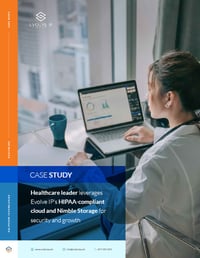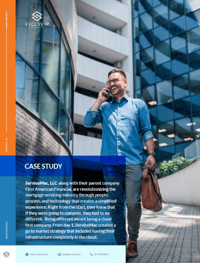
Cloud DaaS (Everything You Need To Know)
Cloud Desktop as a Service, or cloud DaaS, is a cloud computing service where the entire desktop environment is hosted on a remote server and accessed via the internet. Instead of your company applications, files, and data being stored on your personal computer, they're stored on these secure remote servers. This way, your corporate data stays secure in the data center and never lives on user’s edge devices, thereby freeing you from the worry of compromising data due to lost/stolen end-points.
This also means users can use any desktop, laptop or mobile device, to work anywhere, as long as they have an internet connection. It's a flexible solution that's managed by a service provider, making it easier for IT to support remote work and manage company resources.
Here are a few ways that cloud DaaS can be useful to a business:
- Enables employees to access their desktops from anywhere, on any type of device, providing a flexible solution for remote work.
- Allows for easy scalability with the ability to add or remove desktops as needed within minutes vs. days, ideal for businesses with a fluctuating workforce.
- Free IT from the time consuming administrative tasks such as software updates, maintaining devices, pushing patches, application delivery, ideal for IT teams that are overburdened and unable to spend time on strategic projects
- Ensures work can continue even if the physical office space is inaccessible, as desktops are hosted in the cloud.
- Provides temporary desktops for creating and testing software, eliminating the need for physical hardware and allowing for easy cleanup post-project.
- Provides a centralized location to access, control and manage resources vs. having individual centralized solutions for desktops, servers, security, licensing, storage, collaboration etc.
What is DaaS in Cloud Computing?
Cloud computing is a broad field that encompasses a range of services, from infrastructure to software. DaaS, or Desktop as a Service, is a specific type of cloud service that falls under the umbrella of cloud computing.
In the cloud computing stack, you have three main categories: Infrastructure as a Service (IaaS), Platform as a Service (PaaS), and Software as a Service (SaaS). DaaS is often considered a subset of SaaS, but it's unique in that it provides a full desktop experience, delivered over the cloud.
“Cloud DaaS”, “Managed DaaS”, and “DaaS” are often used interchangeably, but technically, DaaS solutions can also be implemented on-site. Virtual Desktop Infrastructure (VDI) is a technology that allows users to access their desktop environments remotely, even though it’s typically managed in-house by an organization's tech department.
In cloud-based DaaS, however, VDIs are hosted by a third-party service provider on a remote server off-site. This allows for better security, compliance, and redundancy in the event of a disaster or attack.
While cloud DaaS is arguably the more well-rounded option it still isn’t for everybody. However, it can be highly useful in specific scenarios where flexibility and customizability are required.
Here are some examples:
- A company that is rapidly expanding and hiring new employees can use DaaS to quickly set up necessary workstations without the need for physical hardware setup.
- A consulting firm working on a large project hires a team of temporary workers. DaaS allows the firm to provide these workers with the necessary tools and access for the duration of the project, and then easily remove access once the project is completed.
- A healthcare organization needs to ensure data privacy and compliance with regulations like HIPAA. DaaS providers offer robust security measures, making it a suitable choice for such a scenario.
- A business located in a region prone to natural disasters can use DaaS to ensure that their operations can continue even if their physical office space becomes inaccessible.
- A software development company can use DaaS to provide developers with a controlled and consistent environment, which can be especially useful when testing new software.
- A university transitioning to online learning can use DaaS to provide students with access to necessary software and resources from their own homes.
In this guide to cloud DaaS, we will dive deep into the world of desktop-as-a-service solutions, walking you through its implementation, various examples, and potential benefits. If you’re an IT lead in-charge of leading digital transformation at your organization, this is everything you need to get started exploring desktop-as-a-service solutions.
Benefits of Cloud DaaS
DaaS is not just any cloud-based solution—it's a powerful tool that can drive operational efficiency, enhance security, and provide the flexibility modern businesses need to thrive in a fast-paced digital landscape. Here’s an outline of key DaaS benefits:
Cost Efficiency
DaaS can be more cost-effective than traditional desktops. It eliminates the need for businesses to invest in expensive hardware and the ongoing costs of maintenance and upgrades.
Scalability
DaaS allows businesses to easily scale up or down based on their needs. New desktops can be added quickly and easily, making it a flexible solution for growing businesses.
Security
With DaaS, all data is stored in the cloud, not on the device. This can improve security, as there is less risk of data being lost or stolen if a device is compromised.
Accessibility
DaaS allows users to access their desktops from anywhere, on any device. This makes it a flexible solution for businesses with remote employees or those who travel frequently.
Simplified Management
With DaaS, the service provider handles much of the IT management, including maintenance, updates, and data backup. This can free up time for the business's IT team to focus on other tasks.
How Cloud DaaS Works
Imagine your computer desktop with all its files and applications. Now, instead of that being physically located on your computer, imagine it's stored on a powerful server somewhere else, and you can access it over the internet. That's the idea behind cloud DaaS.
Let’s break down each component of this technology so that you can better understand how it all comes together:
Cloud Servers: These are powerful computers located in data centers around the world. They host the virtual desktops and run the applications. They have high-speed connections to the internet to ensure smooth and fast access for users.
Virtualization Software: This is the software that creates and manages the virtual desktops on the servers. It divides the server's resources (like processing power, memory, and storage) into separate virtual machines (VMs), each of which can run its own desktop environment.
Connection Broker: This is a key component that manages the user's connection to their virtual desktop. When a user logs in, the connection broker determines which virtual desktop they should connect to, and establishes and maintains that connection.
User Portal: This is the interface that users interact with to access their virtual desktop. It could be a web portal that you access through a browser, or a dedicated application on your device. The user portal handles authentication (making sure you are who you say you are) and provides a window into your virtual desktop.
Operating System Images: These are the 'templates' for the virtual desktops. They contain the operating system and any standard applications that every user needs. When a new virtual desktop is created, it starts with one of these images.
Application Delivery: This is how individual applications are delivered to each virtual desktop. Some applications might be installed in the base image, but others might be delivered separately, either 'streamed' on demand or assigned to specific users based on their needs.
Storage: This is where user data and profiles are stored. In a DaaS environment, this is typically separate from the virtual desktop itself. This means that even if a virtual desktop is shut down or reset, the user's data and settings are preserved.
Network Infrastructure: This includes all the hardware and software that connects the user's device to the cloud servers. It needs to be robust and high-performing to ensure a smooth user experience.
Security Measures: These include firewalls, encryption, and intrusion detection systems to protect the servers and the data they hold. They also include user authentication systems to ensure that only authorized users can access their virtual desktops.
All of these components work together to create a DaaS environment where users can access their own work desktop from any device, anywhere, while the service provider takes care of all the technical details behind the scenes.
One click on a scam email and an employee could accidentally give a hacker access to everything on their device.
Implementing Cloud DaaS
Before you consult with a DaaS provider about implementing a cloud computing service in the workplace, it’s important to have some idea of how desktop-as-a-service solutions are set up in a work setting. Here’s a generalized overview of the steps your organization will need to go through:
Assessment
Understand your organization's needs, including the number of users, types of applications, and data storage requirements. This will help you determine the scale of the DaaS solution you need.
Selection
Research various DaaS providers to understand their offerings, pricing, and reputation. Consider factors such as data center locations, uptime guarantees, and security measures.
Migration Planning
Plan the migration process in detail. This includes addressing potential challenges related to data migration, application compatibility, and network connectivity.
Implementation
Work with your chosen DaaS provider to implement the solution. This includes setting up user accounts, configuring virtual desktops, and migrating data.
Training
Train your employees on how to use the DaaS solution. This includes how to access their virtual desktop, how to use the applications, and how to store and retrieve data.
Monitoring & Maintenance
Once the DaaS solution is implemented, ongoing monitoring and maintenance are necessary to ensure optimal performance and security. This includes regular updates, performance monitoring, and responding to any issues or concerns.
Next, let’s talk about a few best practices for successfully implementing desktop-as-a-service solutions in the workplace:
Preparation:
- Understand Your Needs: Identify the specific needs of your organization and how DaaS can meet those needs. This includes understanding the types of applications your users need, the level of performance required, and the devices they will be using.
- Assess the Network: Ensure your network has the capacity to handle the increased traffic that will come with DaaS. This may involve upgrading your network infrastructure or increasing your internet bandwidth.
- Plan for Scalability: DaaS allows for easy scalability, but it's important to plan for this from the outset. Consider how your needs may change in the future and ensure your DaaS solution can accommodate this growth.
Deployment:
- Choose the Right Provider: Different DaaS providers offer different features, so it's important to choose one that aligns with your organization's needs. Consider factors such as the provider's reliability, security measures, and customer support.
- Train Your Users: Ensure your users understand how to use the DaaS solution effectively. This may involve providing training or resources to help them get up to speed.
- Monitor Performance: Once the DaaS solution is deployed, monitor its performance to ensure it's meeting your organization's needs. This can help you identify any issues early and make necessary adjustments.
Security:
- Implement Strong Access Controls: Use features like multi-factor authentication to ensure only authorized users can access your DaaS solution.
- Train Employees on Security Best Practices: This can help prevent security issues caused by user error.
- Keep Software Up to Date: Regularly update your DaaS software to protect against the latest security threats.
Optimization:
- Use Power Management Features: Many DaaS platforms offer power management features that can help you save on resource consumption. For example, they can automatically scale up instances based on the number of active users, and then scale down when the VMs are no longer needed.
- Optimize for User Experience: Consider factors like load times and application performance to ensure your DaaS solution provides a good user experience.
- Regularly Review Your DaaS Strategy: As your organization's needs change, your DaaS strategy should evolve to match. Regularly review your strategy to ensure it's still effective.
Cloud DaaS Examples
Evolve IP is a cloud services company that provides organizations with a unified and integrated platform that includes disaster recovery, contact center, unified communications, desktop virtualization, and identity access management services. These services are designed to improve productivity, security, and compliance for businesses across different industries and verticals.
Over the years, we’ve worked with a number of companies to aid in the implementation of their digital transformation. Here are a few examples of successful DaaS implementations from our history book:
Johnson Investment Counsel
FINANCE
Goals: To enable all employees to work from home during the COVID-19 pandemic.
Implementation: Johnson Investment Counsel, one of the Midwest’s largest financial advisory firms, used Evolve IP's DaaS solution to enable all of their employees to work from home, consult with clients, handle investment trades, and manage their business seamlessly.
Halfpenny
 HEALTHCARE
HEALTHCARE
Goals: To securely host private client and patient data while meeting HIPAA and HITRUST compliance requirements. They aimed to continuously enhance their business continuity profile and improve system performance and stability.
Implementation: Halfpenny Technologies has hosted their private client and patient data securely on Evolve IP’s cloud infrastructure for seven years. To meet HIPAA and HITRUST compliance requirements and ever-changing data security demands, HTI is continuously enhancing their business continuity profile and improving system performance and stability.
ServiceMac, LLC
MORTGAGE SERVICING
Goals: To revolutionize the mortgage servicing industry through people, process, and technology.
Implementation: ServiceMac, along with their parent company First American Financial, utilized Evolve IP's DaaS solution to have their infrastructure completely in the cloud from day one. Being a cloud-first company was a key element of their go-to-market strategy.
5 Best Cloud DaaS Solutions
There are several cloud computing companies that specialize in providing desktop-as-a-service solutions to businesses across various industries. Here’s a rundown of the best DaaS providers:
Evolve IP
Evolve IP's DaaS solution offers a comprehensive suite of features that make it a standout choice for businesses seeking a robust and reliable cloud-based desktop service. The solution provides users with a unified workspace that can be accessed from anywhere, on any device, and at any time. This workspace includes applications, data, and services, all of which are securely hosted in the cloud.
One of the key features of Evolve IP is its comprehensive security measures. The solution includes intrusion detection and prevention, patch management, and disaster recovery services. It also offers robust compliance capabilities, with support for standards such as HIPAA and PCI DSS.
Evolve IP also includes a host of productivity-enhancing features. These include the ability to integrate with Office 365 and other productivity tools, as well as the ability to customize the user experience with personalized desktops and applications.
Moreover, Evolve IP is designed for scalability. It can easily accommodate changes in the size of your workforce, making it an ideal choice for businesses that are growing or have fluctuating staffing levels.
Amazon WorkSpaces
Amazon WorkSpaces is a managed DaaS solution that lets you provision virtual, cloud-based Microsoft Windows or Amazon Linux desktops for your users. It provides a broad range of desktop configurations to cater to your specific needs.
Key features include the ability to integrate with your corporate Active Directory to maintain user profiles and existing group policy objects, built-in data encryption at rest and in transit, and the option to use multi-factor authentication for enhanced security.
Citrix Virtual Apps and Desktops
Citrix Virtual Apps and Desktops is a DaaS solution that provides secure remote access to Windows applications and desktops from any device, over any network.
It offers a high-definition user experience on any device, centralized security and access control, and the ability to scale up or down on demand.
VMware Horizon Cloud
VMware Horizon Cloud enables the delivery of cloud-hosted or on-premises virtual desktops and apps to any device, anywhere, from a single cloud control plane.
Key features include a cloud monitoring service that provides detailed metrics and analytics, a unified workspace for simplified access to desktops and apps, and intrinsic security with integrated technologies from the VMware ecosystem.
Microsoft Azure Virtual Desktop
Azure Virtual Desktop, formerly known as Windows Virtual Desktop, is a comprehensive DaaS solution that enables secure remote work by providing users with a Windows 10 or 11 desktop experience that can be accessed from anywhere.
Key features include the ability to use existing eligible Microsoft 365 or Windows per-user licenses to reduce costs, built-in intelligent security to help keep applications and data secure and compliant, and the ability to deploy and scale in minutes.
Conclusion
Cloud Desktop as a Service (Cloud DaaS) is a model where the entire desktop environment is hosted on a remote server and accessed via the internet, enabling users to access their work desktop from any device, anywhere.
As a subset of Software as a Service (SaaS), Cloud DaaS provides a full desktop experience over the cloud. While DaaS solutions can be implemented on-site, cloud-based DaaS solutions are hosted by a third-party service provider, offering enhanced security, compliance, and redundancy. A few other benefits of Cloud DaaS include cost-efficiency, scalability, improved security, accessibility, and simplified management.
Rolling out a DaaS solution typically involves hosting virtual desktops on cloud servers, managed by virtualization software. Users access their virtual desktop through a user portal, with a connection broker managing the user's connection. Best practices for successful implementation include understanding your needs, planning for scalability, choosing the right provider,implementing strong access controls, training employees on security best practices,using power management features, and more.
Are you looking for an end-to-end desktop virtualization service to aid in your organization’s digital transformation. Evolve IP is a cloud services company that provides DaaS solutions and has successfully implemented DaaS solutions for companies like Halfpenny Technologies Inc., Johnson Investment Counsel, and ServiceMac, LLC. Want to learn more about how we can help?

Simplify and future-proof your technology footprint with Evolve IP







It's nearly impossible to stay on top of every change in technology. Partner with Evolve IP and gain the combined experience of hundreds of technologists, all acting as an extension of your IT team. Helping you do more with less.




